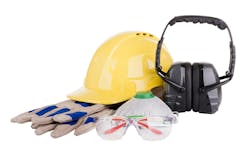The Critical Role of Workwear in Enhancing Machine Safety: An Integrated Approach
What’s in a uniform? A lot more than company branding and cotton. The manufacturing industry relies on team attire in several respects beyond mere aesthetics, with safety being a particularly important yet often overlooked area of intersection.
With injuries resulting from contact with objects and equipment being among the top causes of work-related death, physical protection serves as the first line of defense against workplace hazards. However, the role of workwear in manufacturing safety extends far beyond mere physical protection. It’s a crucial component in a complex system of safety measures that includes machine design, workplace protocols and ergonomic considerations.
There is an intricate relationship between workwear and machine safety in manufacturing environments. Thoughtful integration can close safety gaps, reduce workplace accidents and ultimately save lives.
Understanding the Risks of Manufacturing Work
It’s no secret that manufacturing environments are hazard-rich. The very nature of work performed within them—heavy lifting, large-scale and high-speed machine operations, and exposure to various materials—is inherently risky. Every employer has the dual moral and legal responsibility to protect workers from injury.
The Occupational Health and Safety Association (OSHA) sets out standards for proper environmental assessments, worker training and employee review. It also emphasizes the importance of personal protective equipment (PPE)—a first line of defense against potential harm should fundamental safety measures fail.
READ MORE: Partnership’s Vision for Advanced Manufacturing
In most manufacturing facilities, every part of the body is susceptible to injury. Head trauma can result from falling objects or collisions, eye damage may occur from flying debris or chemical splashes, respiratory issues can arise from exposure to harmful fumes, and hands and fingers can become injured or crushed in machinery. Burns are a constant threat from hot surfaces, molten materials or chemical exposure. Electrical hazards pose risks of shock or electrocution. Repetitive motion injuries can develop over time from prolonged machine operation. Noise-induced hearing loss is common in loud manufacturing environments. Slips, trips and falls remain a persistent danger due to wet or oily surfaces.
According to OSHA, there were 2,074 violations for inadequate eye and face protection in 2023. That marked an increase of nearly 700 violations compared to the year prior. Respiratory protection is another top 10 violated category, which also saw an increase of violations in 2023.
The Intersection of Workwear and Machine Safety
PPE encompasses every wearable item or accessory workers use to protect themselves in the workplace. Safety glasses, earplugs, respirators, gloves and protective footwear each insulate specific body parts from physical and airborne risks in the hopes of minimizing on-the-job injuries and deaths.
While PPE alone is often enough for employee safety in healthcare environments, teams in the manufacturing sector require additional safeguards. Machine safety features such as emergency stop buttons, safety guards, light curtains, interlocking systems and automatic shut-off mechanisms are designed to either prevent worker contact with dangerous parts of the machine or to quickly stop machine operation in case of an emergency.
READ MORE: Put a Ring on It: Digital PPE Pick Up Coronavirus Symptoms
The industry has long looked at these two measures as separate, where PPE and machine safety are planned in silos. It worked to an extent considering that worker deaths in America have steadily declined from about 38 fatalities a day in 1970 to 15 fatalities a day in 2022.
But there’s still much more room for improvement. Gaps remain in worker protection—ones that aren’t obvious or necessarily inherent to manufacturing specifically. A big part of the risk workers face today stems from a lack of consideration for how PPE and machine safety features interact with each other.
This siloed approach, while effective to a degree, often leaves gaps in worker protection. For instance, a machine’s emergency stop button might be out of reach for a worker wearing bulky protective gloves or a safety guard could interfere with the visibility provided by safety goggles.
Recognizing this limitation, forward-thinking manufacturers and safety experts have begun to advocate for a more holistic approach to workplace safety. They propose viewing PPE and machine safety not as distinct entities, but as complementary components of a unified safety system.
Designing for Safety: Integrating PPE Considerations in Machine Design
When properly integrated with machine design and safety protocols, PPE forms a robust defense against the myriad risks present in manufacturing settings. This integration requires a paradigm shift in machine design philosophy. Instead of treating PPE as an afterthought, designers must consider it from the outset.
Employers have a similar responsibility to consider how the PPE they require staff to wear might interfere with machine operations and how machines themselves can be configured to accommodate PPE requirements. This holistic approach ensures that safety measures work in harmony, rather than potentially conflicting with each other.
For example, the physical layout of machinery should consider the extra space needed for workers wearing protective clothing. Ample clearance around moving parts can prevent accidental contact, even when PPE adds bulk to a worker’s profile.
Although far from accessible enough to become mainstream, smart PPE promises to revolutionize workplace safety. Using Internet of Things (IoT) connected devices, it facilitates coordination between workers and machines.
Selecting the Right Workwear for Specific Machinery
From hard hats and safety glasses to respirators, gloves and steel-toed boots, each piece of PPE plays a vital role in safeguarding workers. Although there isn’t a universal “best” PPE solution for all manufacturing environments, certain principles guide the selection process. The nature of the machinery, potential hazards and the specific tasks workers perform all influence PPE choices. American-made workwear brands stand out for their commitment to quality and durability, essential for effective protection in rigorous environments.
READ MORE: Thanks for Sharing: Reusable Open Source Hardware Respirators
For instance, when working with cutting machines, cut-resistant gloves are essential. However, these gloves must not be so bulky that they impair dexterity or increase the risk of entanglement. Similarly, safety goggles for welding operations need to provide adequate protection against UV radiation and flying sparks while maintaining clear visibility.
It's crucial to consider how different pieces of PPE interact with each other and with the machinery. A hard hat, for example, should be compatible with earmuffs or safety glasses without compromising the effectiveness of either. Respirators must not interfere with eye protection or communication devices.
Regular assessment and updates to PPE selections are necessary as machinery and processes evolve. The OSHA standard 1910.132 provides guidelines for PPE selection, although input from a qualified safety professional is invaluable as well.
How Ergonomics Impact Worker Safety in Manufacturing
Ergonomics is often misunderstood to be all about an enjoyable user experience when, in reality, it has a big influence on safety as well. Comfort and proper use go hand-in-hand.
Consider a welding helmet with an auto-darkening feature. This ergonomic improvement not only protects the welder’s eyes but also eliminates the need for constant manual adjustments, reducing neck strain and improving work efficiency. On the machinery side, touchscreen interfaces at eye level can replace hard-to-reach buttons, minimizing the need for awkward stretching or bending.
A little forethought goes a long way in mitigating risks.
Proactive Risk Management
While machines can be designed with numerous safety features, they cannot eliminate all risks. Conversely, even the best PPE cannot compensate for poorly designed or unsafe machinery. The turbulent and complex environments in which manufacturing employees work today call for a smarter approach to risk management. Every employer has the obligation and ability to prioritize safety and, by all indications, merging PPE considerations with machine design is the best way to do so.
Editor’s Note: Machine Design’s WISE (Workers in Science and Engineering) hub compiles our coverage of workplace issues affecting the engineering field, in addition to contributions from equity seeking groups and subject matter experts within various subdisciplines.
About the Author

Nick Warrick
Sales Manager, All Seasons Uniforms
Nick Warrick is sales manager at All Seasons Uniforms.

